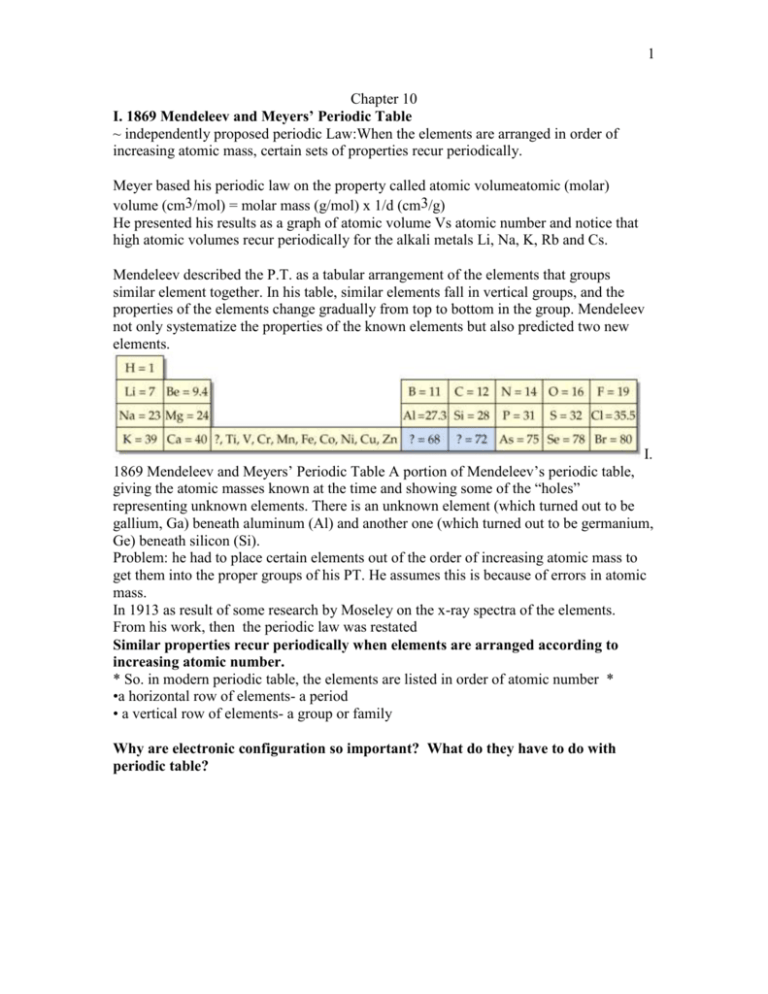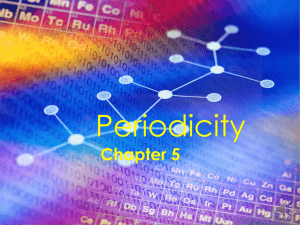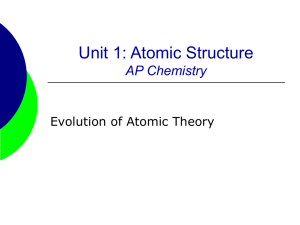Chapter 10
advertisement

1 Chapter 10 I. 1869 Mendeleev and Meyers’ Periodic Table ~ independently proposed periodic Law:When the elements are arranged in order of increasing atomic mass, certain sets of properties recur periodically. Meyer based his periodic law on the property called atomic volumeatomic (molar) volume (cm3/mol) = molar mass (g/mol) x 1/d (cm3/g) He presented his results as a graph of atomic volume Vs atomic number and notice that high atomic volumes recur periodically for the alkali metals Li, Na, K, Rb and Cs. Mendeleev described the P.T. as a tabular arrangement of the elements that groups similar element together. In his table, similar elements fall in vertical groups, and the properties of the elements change gradually from top to bottom in the group. Mendeleev not only systematize the properties of the known elements but also predicted two new elements. I. 1869 Mendeleev and Meyers’ Periodic Table A portion of Mendeleev’s periodic table, giving the atomic masses known at the time and showing some of the “holes” representing unknown elements. There is an unknown element (which turned out to be gallium, Ga) beneath aluminum (Al) and another one (which turned out to be germanium, Ge) beneath silicon (Si). Problem: he had to place certain elements out of the order of increasing atomic mass to get them into the proper groups of his PT. He assumes this is because of errors in atomic mass. In 1913 as result of some research by Moseley on the x-ray spectra of the elements. From his work, then the periodic law was restated Similar properties recur periodically when elements are arranged according to increasing atomic number. * So. in modern periodic table, the elements are listed in order of atomic number * •a horizontal row of elements- a period • a vertical row of elements- a group or family Why are electronic configuration so important? What do they have to do with periodic table? 2 For example, the Group 1 elements all have an s1 valence-shell configuration; the group 2 elements have an s2 valence-shell configuration; and so on. Because the valence-shell electrons are the most loosely held, they are the most important for determining an element’s properties, thus explaining why the elements in a given group of P.T. have similar chemical behavior. The P.T. can also be divided into four regions, or block, of elements according to the orbitals being filled. Blocks of the periodic table, corresponding to filling the different kinds of orbitals. Beginning at the top left and going across successive rows of the periodic table provides a method for remembering the order of orbital filling: 1s > 2s > 2p > 3s > 3p > 4s > 3d > 4p, and so on. II Metals and Nonmetals and Their Ions Noble Gases (ns2np6) ~ These element are known as noble gas (inner gases) because of their relative unreactivity. In 1960s several compounds of xenon were formed. Main-group metal ions ~ tend to lose electrons to attain noble gas electron configuration K ([Ar]4s1) K+ ([Ar]) + eMain-group nonmetal ions ~ tend togain electron to attain noble gas electron configuration. Cl ([Ne]3s23p5) + e- Cl- ([Ar]) Transition metal ionsFrom aufbau process the ns subshell fills before electrons enter the (n-1)d subshell, but when transition metal atoms ionize the ns electrons are removed before (n-1)d electrons. Fe([Ar]3d64s2) Fe2+ ([Ar]3d6) + 2eIII General Periodic Trend i The size of atoms and ions Atomic radius Atomic radius of a metallic element is that it is half the distance between the nuclei of neighboring atoms in the crystalline solid at room temperature and pressure. 3 The covalent radius is one-half the distance between the nuclei of two identical atoms joined by a single covalent bond (A covalent Bond: can be described as a pair of electrons shared by two atoms). The ionic radius is based on the distance between the nuclei of ions joined by an ionic bond. Because the ions are not identical in size, this distance must be properly apportioned between cation and anion. There is no precise outer boundary to an atom. The atomic radius we measured is an effective atomic radius, the distance from the nucleus within which 90% of all electron charge density is found. Atomic radii for individual atoms can then be used to predict the bond length between two different atoms. For main group (s and p block) elements In transition series Atomic radii of transition elements tend to be about the same across a period Atomic radii of the elements in picometers 4 Ionic radius. For a given atom · Cation <neutral <anion Why? E.g. Radii of (a) group 1A atoms and their cations; (b) group 2A atoms and their cations. The cations are smaller than the neutral atoms both because the principal quantum number of the valence-shell electrons is smaller for the cations and because Zeff is larger. Radii of the group 7A atoms (halogens) and their anions. The anions are larger than the neutral atoms because of additional electron-electron repulsions and a decrease in Zeff. Insoelectronic- elements, compounds or ions that have the same number of valence electrons. E.g. N2 and CO are isoelectronic.For isoelectronic cations, the more positive the ionic charge, the smaller the ionic radius. For isoelectronic anions, the more negative the charge, the large the ionic radius. E.g. Which of the following statements is incorrect? a) I- has a larger radius than I. b) Fe3+ has a smaller radius than Fe. c) Se2- has a larger radius than Br. d) Ca2+ has a larger radius than Ca. 5 E.g. Compare the following species in order of increasing size: Ti2+, V3+, Ca2+, Brand Sr2+ IV Ionization Energy, I, (Ionization potential) ~ The energy necessary to remove an electron from an isolated atom or ion in the gas phase. It is the energy difference between the highest occupied energy level and that corresponding to n=, that is complete removal. ·Ionization energies are always endothermic. I = RH x Z2eff n2 E.g. ionization of an H atom I1: first ionization energy- the energy required to removed one e- from a neutral gaseous atom. I2: second ionization energy- the energy required to removed one e- from a gaseous ion with a charge 1+. For Main group elements: 6 Within a given energy level, more energy is required to remove an electron from an s orbital than is required to remove an electron from a p orbital. Within a set of orbitals at the same energy level, more energy is required to remove an electron from a half-filled orbital than from a filled orbital. E.g. Which of the following atoms has the highest first ionization energy? a) P b) Sb c) As d) N V Electron Affinity (EA) ~ is conventionally defined as the energy released when an electron is added to the valence shell of an gaseous atom. E.g. Measured electron affinities for elements 1-57 and 72-86. A negative value means that energy is released when an electron adds to an atom, while a value of zero means that 7 energy is absorbed but the exact amount can’t be measured experimentally. Note that the group 2A elements (alkaline earths) and the group 8A elements (noble gases) have EA values near zero, while the group 7A elements (halogens) have large negative EA’s. Accurate electron affinities are not known for elements 58-71. The acceptance of the electrons by active nonmetal is initially exothermic. Why should a neutral atom so readily gain an electron? A plausible explanation is that when a free electron approaches an atom from infinite distance away, the electron sees a center of positive charge- atomic nucleus- to which it is attracted. This attraction is offset to some extend by the repulsive effect of other electrons in the atom, so long as the attraction force on the additional electron exceeds the repulsion force, the electron is gained and the energy is given off. However, the atoms become saturated relatively quickly, the energy reaches a minimum, and further addition of electrons is endothermic. In fact, for dinegative ions such as O2and S2-, the total EA is positive. EA trend in PT parallel those of I. Elements with large I tend to have large EA as well except F < Cl, N < P and O<S due to the smaller size of the second row elements and consequent greater electron-electron repulsion in them. Although initially they have greater tendencies to accept electrons, they quickly saturated as the e-—e- repulsion rapidly dominates. VI Magnetic Properties In a diamagnetic atom or ion, all electrons are paired and the individual magnetic effect cancel out. A paramagnetic atom or ion has unpaired electrons, and the individual magnetic do not cancel out. The unpair electron posses a magnetic moment that cause the atom or ion to be attracted into an external magnetic field. The more unpaired electrons present, the stronger is this attraction. E.g. VII Summary of Periodic Properties of the Elements Atomic properties: atomic radius, ionization energy, electron affinity IE, EA Atomic radius EA IE Atomic radius 8 Variation of Physical Properties Across a PeriodReducing ability of group 1 and 2 The reducing agent itself by losing electron, is oxidized. 2M(s) + 2H2O(l) 2M+(aq)+ 2OH-(aq) +H2(g) M(s) + 2H2O(l) M2+(aq)+ 2OH-(aq) +H2(g) M =group 1 or group 2 metals In general, the lower the I of the metal, the better the metal is as a reducing agent and the more vigorous its reaction with water. Other factors should be consider as well when make comparison. Oxidizing abilities of the Halogen Elements (group 17) An oxidizing agent, by gaining electrons, itself reduced. Atoms with a strong tendency to gain electrons ( a large negative EA) are good oxidizing agents. Acid-Base nature of element oxides A basic oxide (basic anhydride) is an oxide that reacts with acids. Most metal oxides are basic oxides. CaO(s) + H2O(l) Ca2+(aq) +2OH (aq) An acidic oxide (or acid anhydride) is an oxide that reacts with bases. Most nonmetal oxides are acidic oxides. The solube acidic oxides dissolve in water to produce acidic solution CO2(g) + H2O(l) H2CO3(aq) Aluminum oxide can act as either acidic or basic oxide. A substance that has both acidic and basic properties is called smphoteric substance. Al2O3 (s) + 6H+(aq) Al3+(aq) + H2O(l) Al2O3 (s) + 2OH-(aq) Al(OH)4-(aq) The Amphoterism of signifies the point at which a changeover from basic to acidic oxide occurs in the third period of elements.









